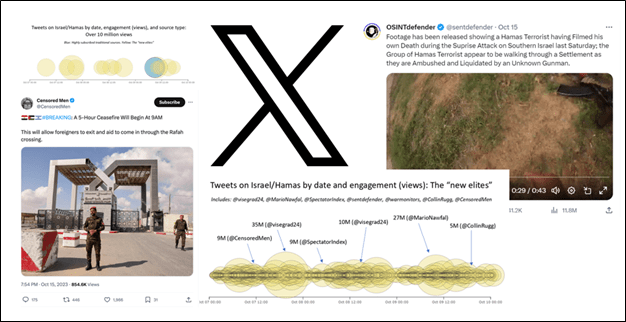RAPID RESEARCH REPORT
By Mike Caulfield, Mert Can Bayar and Ashlyn B. Aske
University of Washington
Center for an Informed Public
Since the first news of the attack on Israel by Hamas, we have seen anecdotal reports from users of X (formerly Twitter) that the platform has become less useful for surfacing verified news and more generally disorienting. Through a novel data collection process we identify highly influential accounts in the Hamas/Israel discourse on X that comprise the most dominant English-language news sources on Twitter for the event. In this Center for an Informed Public rapid research report, we compare these accounts to traditional news sources and find on average they have far fewer subscribers while achieving far greater views, are of more recent popularity, and show a greater posting frequency. Most of the accounts also use video and images frequently, framed in emotional ways. Strikingly, many of these accounts have received prior promotion from X owner Elon Musk, either through direct recommendation or through Musk’s account replying to their content, which may explain some of their dominance of “news twitter.”
With seven accounts racking up a cumulative 1.6 billion tweet views over three days of posts, our analysis points to a new crisis twitter that is faster, more disorienting, and potentially more shaped by Musk himself.
- A Note on Terminology: Following a common practice in academic scholarship, we refer to the different elements of X (tweets, retweets, likes, follows) by the terms used in the community itself. Likewise, we use terms like “news twitter” and “crisis twitter,” both lower case, as the common names used on X to refer to these communities or discourse subgroups. When referring to the platform itself or associated policies, we use the term “X,” the legal name of the platform.
Identifying the most influential accounts in the Hamas/Israel discourse on X
Up until last spring social media researchers had access to Twitter/X data through a number of options, commonly referred to as “APIs.” These APIs allowed researchers to quickly observe and analyze behavior on Twitter in the moment, as it happened, with precision and at scale. Since spring of 2023 these options are prohibitively expensive for many researchers, making it more difficult to make confident large-scale assertions about behavior on the platform.
Still, we are evolving methods for research and rapid analysis in the absence of these tools. Here, we first identified the accounts that were most influential — as measured by overall views on the most engaged-with content on the platform. To do this, we collected from the search interface on X all tweets that mentioned specific key terms (e.g., “gaza,” “israel,” “hamas”) and had at least 500 likes. We chose a three-day period from midnight Pacific time on October 7 (as the attack was first being reported) to midnight Pacific time October 10. For each X user in the collection, we totalled the number of views for their tweets over that period. For instance, a user that had tweeted three times, and received 10,000 views on the first tweet, and 20,000 views on two subsequent tweets, would have 50,000 total views.
Once we had a list of 10 highly influential accounts, we removed two that were not primarily news-focused accounts: @elonmusk (ranked 7th), @POTUS (ranked 10th). We also removed one non-English account, @AlertaNews24 (ranked 4th). We then collected all tweets from the remaining accounts within the time period for the terms specified, regardless of number of likes. We produced the following ranking by total views on posts from midnight October 7 to midnight October 10, Pacific time, as captured on October 14.
We refer to these seven accounts below as “the new elites,” as this small group of users are responsible for a significant amount of the content currently seen in the twitter discourse around the conflict. “Elites” here does not refer to the quality or nature of their content, but rather their position as a “small [group] of persons who exercise disproportionate power and influence” over what audiences on X read and watch.
Self-description of top 7 news-focused accounts, the “new elites”
| Account Handle | Account Name | Self Description |
| @visegrad24 | Visegrád 24 | “Aggregating and curating news, politics, current affairs, history and culture from Central and Eastern Europe.🇨🇿🇭🇺🇵🇱🇸🇰” |
| @MarioNawfal | Mario Nawfal | “NO BIAS, NO ECHO CHAMBERS: Host of Twitter’s Largest Spaces – CEO of IBC Group – Founder of Froothie” |
| @sentdefender | OSINTdefender | “Open Source Intelligence Monitor focused on Europe and Conflicts across the World. RT ≠ Endorsement. Want to Support my Work? https://ko-fi.com/osintdefender” |
| @spectatorindex | The Spectator Index | “News, media and data from around the globe. Covering politics, economics, science, tech and sport.” |
| @WarMonitors | War Monitor | “Semite 🇱🇧 || Breaking News || Geopolitics || Backup Account: @WarfareBackup || Donate: http://ko-fi.com/warmonitor” |
| @CollinRugg | Collin Rugg | “Co-Owner of Trending Politics | Investor | American 🇺🇸” |
| @CensoredMen | Censored Men | “🎥 Alternative Media | Follow & Hit The 🔔” |
Note: Top 7 accounts are ordered by the total views they received
The “new elites” by total views of relevant tweets
| Rank | Account | Total views across all items | Relevant Items |
| 1 | @visegrad24 | 371,770,355 | 399 |
| 2 | @marionawfal | 366,380,380 | 320 |
| 3 | @sentdefender | 302,243,139 | 402 |
| 4 | @spectatorindex | 204,422,393 | 250 |
| 5 | @warmonitors | 132,843,941 | 320 |
| 6 | @collinrugg | 116,408,073 | 32 |
| 7 | @censoredmen | 98,274,069 | 111 |
The accounts listed here are not a set of “misinformation” accounts, but merely a list of influential accounts on this topic — accounts whose posts get a large number of views and engagement. We discuss these accounts in detail later in the report.
Our approach comes with a number of important caveats:
- The period of time during which we observe and collect data, from October 7 to October 10, may not be representative of tweets during the crisis as a whole, which is ongoing.
- It may be that by collecting only tweets with over 500 likes we missed or down-ranked influential tweeters who get many views cumulatively (and/or are very active) but fall short of that engagement (i.e., likes) threshold on individual tweets.
- The process of collection occurs over time, and a tweet which was not popular at the time we observed it may have become popular afterwards1.
Despite these caveats, we have confidence that the accounts in the table represent highly salient, influential accounts on this topic.
The “new elites” outperform traditional news sources in both total views and views per tweet.
Crisis events often up-end media hierarchies, a pattern which has been noted regarding Twitter before. This up-ending can produce new sets of elites that can outperform traditional sources of news, at least for a period of time. Sometimes these shifts are transient, other times they reshape the social media landscape in more permanent ways. Still other times they amplify shifts already in progress.
We were interested in how the discovered highly influential accounts performed relative to traditional news accounts which many X users follow. We curated a second set of top subscribed news accounts on X. To do this we used a list of the top 100 accounts on X by followers, and selected the six news accounts that made the top 100: CNN Breaking News (19th), CNN (21st), NYTimes (25th), BBC Breaking News (30th), BBCWorld (50th), and Reuters (99th).
Number of followers of traditional news accounts and the “new elites”
| Account Handle | Account Name | Number of followers |
| @CNNbrk | CNN Breaking News | 63.8M |
| @CNN | CNN | 61.7M |
| @NYtimes | New York Times | 55.0M |
| @BBCBreaking | BBC Breaking News | 51.6M |
| @BBCWorld | BBC World News | 40.3M |
| @Reuters | Reuters | 25.7M |
| @spectatorindex | The Spectator Index | 2.5M |
| @MarioNawfal | Mario Nawfal | 1M |
| @sentdefender | OSINTdefender | 802.6K |
| @WarMonitors | War Monitor | 766.3K |
| @visegrad24 | Visegrád 24 | 641K |
| @CollinRugg | Collin Rugg | 530.7K |
| @CensoredMen | Censored Man | 506.1K |
Note: Number of followers indicate the current number of followers current as of October 14, 2023
We collected tweets from the traditional news accounts that matched our search terms, using the same process and date range as for the new elites.
Influence, measured by tweet views, can be looked at in at least two ways.
- First, an account that produces content with consistently high views may be more visible in other users’ feeds, and exert more influence over time, even if no particular piece of content is highly viral.
- Second, individual pieces of highly viral content may break through to audiences that the account may not otherwise reach, expanding the audience which they may aim to influence in the crisis.
Our visualization, seen below, attempts to capture both of these elements. As an example of what a single account looks like, here we show posts from the BBCWorld account, with each relevant tweet represented by a circle, the size of which is indicative of the number of views, and placed on a timeline with the left edge of the circle plotted at the time of posting. Smaller circles are still quite popular tweets here, with even the smallest circles seen here getting substantial views, with a range of views from the 200,000s at the low end to 24 million at the high end — for one highly viral tweet.
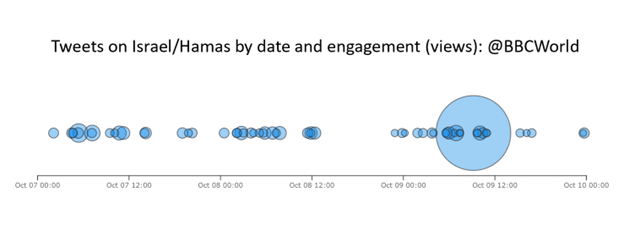
We can put all the traditional news sources on the same timeline (the NYTimes, two CNN accounts, two BBC accounts, and Reuters) to visualize the total influence of these accounts over the three day period. To give a sense of scale, select tweets are labeled.

Across the three day period, topic-relevant tweets from these highly subscribed news sources accumulated 112 million views over 298 tweets (an average of 376K per tweet).
However, topic-relevant tweets from the “new elites” accounts within the study period accumulated 1.6 billion views across 1,834 tweets (an average of 872K per tweet). We visualize this below on the same scale as the graph above.
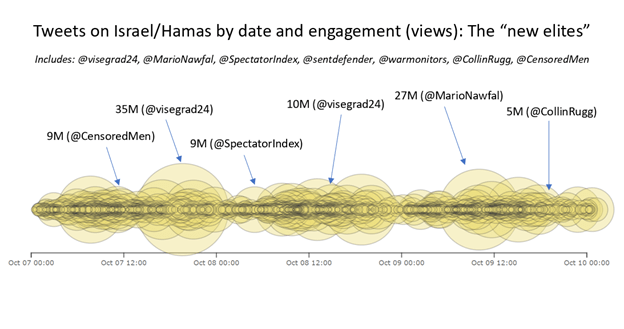
One reason for the high number of views is the posting frequency of these “new elite” accounts, which produce much more material than most traditional news outlets over time. But even accounting for posting frequency, the difference is stark, as we can see we reduce the chart to only tweets that have 10 million views or more.
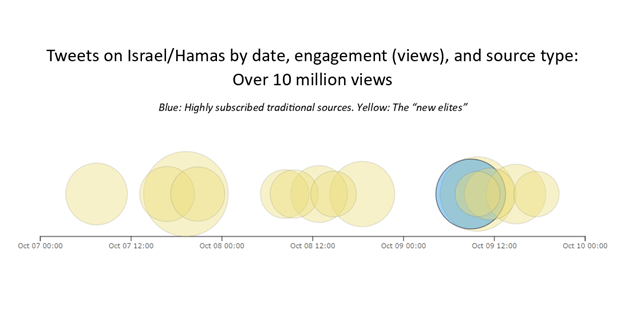
The “new elites” create many such events daily; among the more traditional news sources we see just one tweet of that magnitude (here shown in blue, with the new elites accounts shown in yellow).
Many of the “new elite” accounts are of recent creation or popularity — and most have received direct attention from Musk.
To get a better understanding of the history of these accounts we used the Wayback Machine to determine the number of followers that these accounts had prior to Musk’s announcement he would buy Twitter/X, the point at which he began to exert substantial influence on the platform. In most cases, the amount of followers gained in the last two years was dramatic. (In some cases we could not find a Wayback capture before April 2022, and used the earliest available capture).
“New elites” and the change (%) in their number of followers over the past year and a half
| Account | Current Followers | Previous Followers | Increase (percent) | Account Creation Date |
| @MarioNawfal | 1M | 74.2K (July 2022) | 1,248% | October 2020 |
| @visegrad24 | 641K | 150.5K (March 2022) | 326% | January 2020 |
| @sentdefender | 802.6K | 136K (March 2022) | 490% | November 2021 |
| @spectatorindex | 2.5M | 2.21M (March 2022) | -13% | July 2013 |
| @CollinRugg | 530.7K | 41K (November 2022) | 1,194% | July 2017 |
| @WarMonitors | 766.3K | 18.5K (October 2022) | 4,042% | May 2021 |
| @CensoredMen | 506.1K | 1.6K (January 2023) | 31,531% | December 2022 |
While not the only factor, one key to the surging popularity of these accounts might be Musk himself. Through following many of these accounts, replying to them, and directly recommending them, Musk may be playing a significant role in the increasing prominence of these news-focused sources.
Boosting by replies
Many have noted that Musk uses the power of tweet replies to promote content, boosting small accounts into broader view with short responses, such as “Interesting” or “True.” Because such replies put those accounts in front of some portion of Musk’s 160 million followers, there might be a potential spotlight effect of such action. Looking at these “new elite” accounts, we find that with the exception of one (@spectatorindex), all had received replies from Musk since his acquisition of Twitter.
Number of times Elon Musk replied to the “new elites” after November 2022
| Account | Number of Musk Replies |
| @MarioNawfal | 51 |
| @visegrad24 | 2 |
| @sentdefender | 2 |
| @spectatorindex | 0 |
| @CollinRugg | 38 |
| @WarMonitors | 2 |
| @CensoredMen | 1 |
Recommendations to follow and indications of support
The replies themselves don’t always fully capture the support of Musk for these accounts. For instance, early in the crisis, Musk explicitly recommended two of the accounts (@sentdefender and @warmonitors) as accounts to follow, a recommendation he deleted after concerns were raised about misinformation spread by those accounts in the past. Still, @sentdefender is one of the 468 accounts Musk follows, and as seen below, Musk continues to subscribe to both @sentdefender and @warmonitors.

Musk following the @sentdefender account.
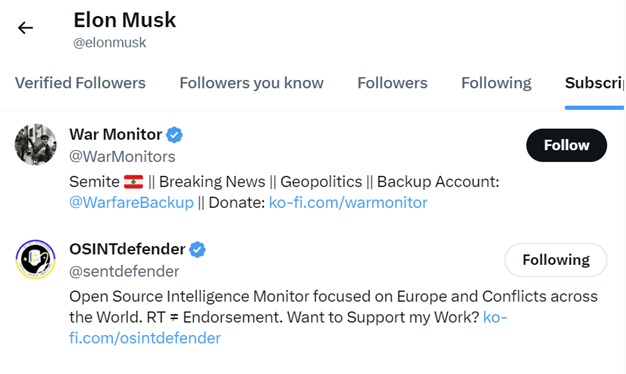
Musk subscribed to the @sentdefender and @warmonitors accounts.
Musk also follows the account of Collin Rugg, a poster who first came to wide prominence with a tweet, boosted by Musk, that defended Musk’s firing of much of Twitter’s engineering staff in November 2022:
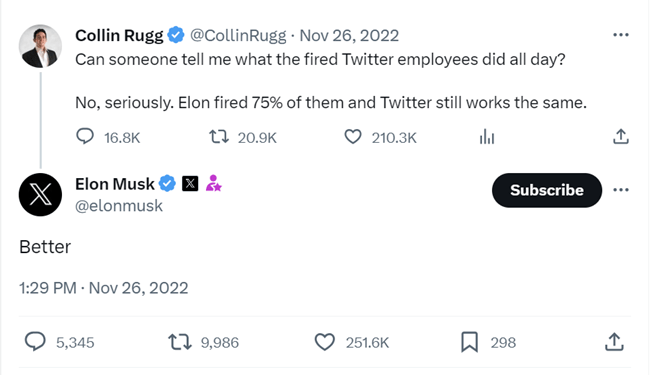
Musk replying to Rugg’s supportive tweet, an action that boosts such tweets to wider audiences
Musk also follows Mario Nawfal. A list of the “new elites” and Musk’s follows/subscribes to is below.
| Account | Musk Follows? | Musk Subscribes? |
| @MarioNawfal | Yes | Yes |
| @visegrad24 | — | — |
| @sentdefender | Yes | Yes |
| @spectatorindex | — | — |
| @CollinRugg | Yes | Yes |
| @WarMonitors | — | Yes |
| @CensoredMen | — | — |
Presence as currency
While not applicable to other accounts, in the case of Mario Nawfal’s account, Musk’s presence at Nawfal’s X Spaces events — live audio events featuring panels of notable speakers — boosted its profile. Nawfal had achieved some notoriety on the Clubhouse platform before migrating to X, but Musk’s presence at the Spaces events likely significantly boosted his profile on X. Musk has also often promoted Nawfal’s work as an example of the “citizen journalism” he wishes to see on the platform.
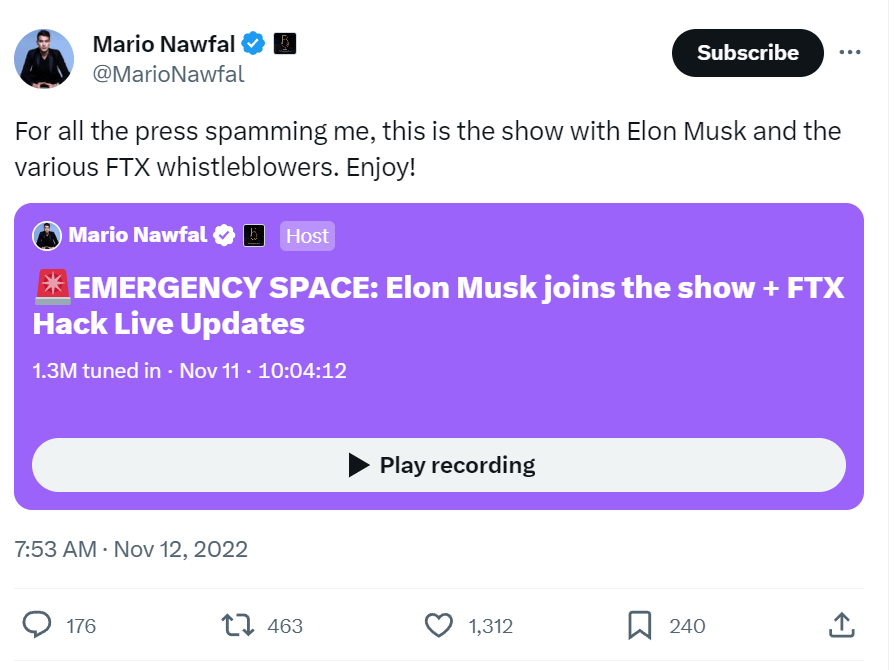
Nawfal’s account promoting a recording of a November 2022 Spaces event featuring Elon Musk
The new elites use X differently than traditional news accounts, in ways that may be disorienting to audiences.
We have defined this group of “new elite” accounts on the basis of their reach in views, but as we talk about the typical qualities of the group as a whole, it is important to recognize that not every statement applies to every account, and many statements are more true of particular accounts than others. To get a good sense of the accounts the best approach is to visit the accounts themselves.
All the same, there are some broader trends associated with this group that are noteworthy and we summarize them here, based on an analysis of these accounts’ total content, rather than just the posts that met our search criteria for Hamas/Israel relevant content.
They post frequently, and many often share “breaking” news that is unsourced or unlinked.
Most of these accounts have predominantly posted “breaking news” on the recent Israel-Palestine conflict, using phrases in the beginning of their tweets such as “BREAKING,” “JUST IN,” and “NEW” to highlight this. Some (@MarioNawfal and @WarMonitors) add emojis that emphasize the nature of these reports, such as a high voltage symbol (@WarMonitors) or a police car light (@MarioNawfal). The majority of the accounts we observed (@MarioNawfal, @sentDefender, @WarMonitors, and @CensoredMen) posted almost exclusively about the Israel-Palestine conflict over the days following Hamas’ attack on Israel, though some covered other topics such as the Ukraine war or breaking news in other countries.
The accounts take various approaches to sourcing, yet in most cases sourcing does not follow traditional journalistic norms. The majority of the accounts and their tweets (@sentDefender, @spectatorindex, @CollinRugg and @CensoredMen) rarely included cited sources. Other accounts, such as @MarioNawfal and @WarMonitors, frequently mention their sources without giving any external links to them, a behavior that may be designed to work around an algorithm that Musk has said will devalue tweets with links. For example:
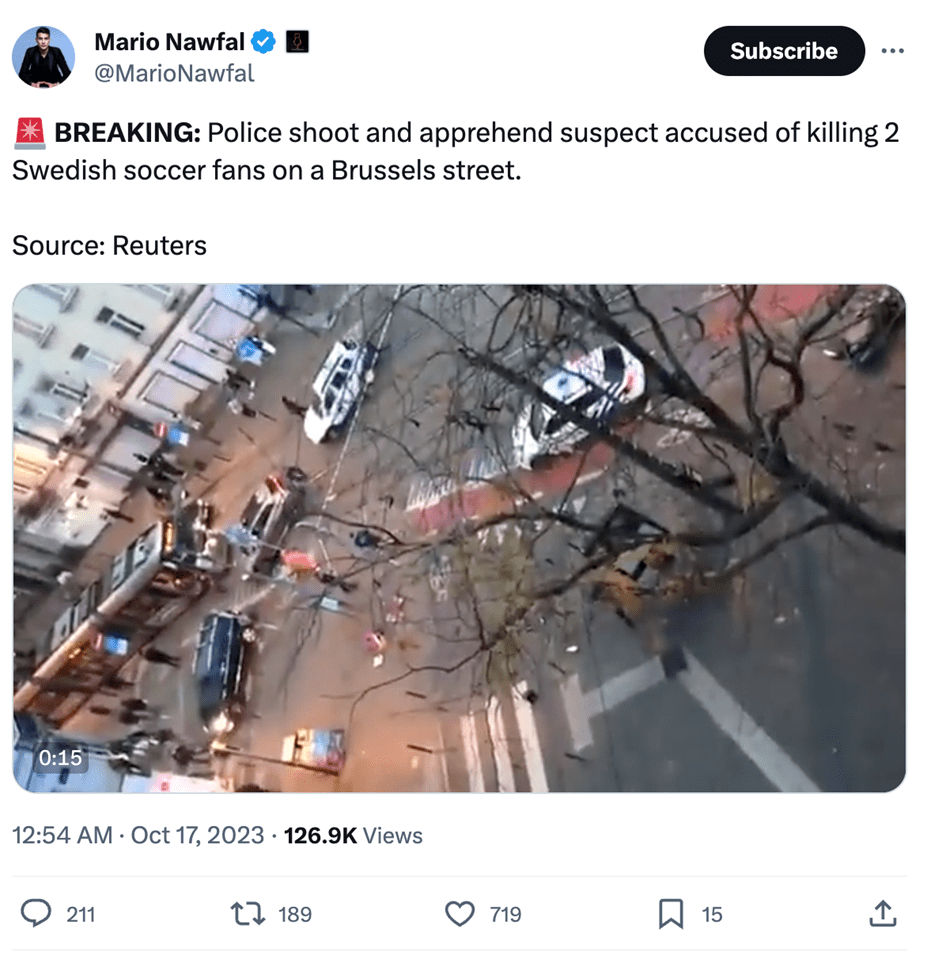
@MarioNawfal’s tweet mentions Reuters as the source of the news without an external link to the story. Whether the video is also taken from the Reuters or somewhere else is not specified.
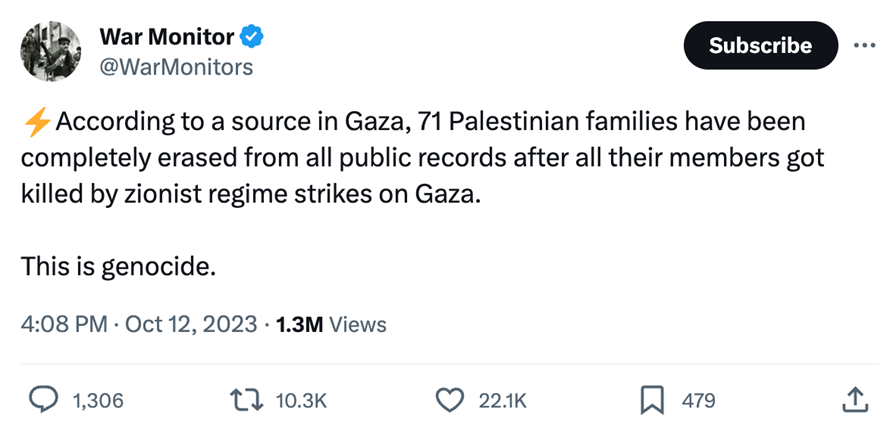
@WarMonitors’ tweet relies on a source in Gaza without verification of the news presented.
@Visegrad24 was an exception here, often posting a link to the original source in a reply to the original post (potentially another workaround).
The lack of robust citations contributes to the decontextualization of the events presented. From the information given, audiences have limited ability to fact check claims or gain a more nuanced understanding of them. Given X’s current approach to external links, it also raises the question of whether these new elites are forging a new style — or being forged by algorithmic changes at X.

@CensoredMen’s tweet about a rumor of ceasefire between Israel and Hamas, later denied by Israel.
The content is often emotionally charged.
The content posted by many of these accounts includes substantial footage of violence, or is otherwise emotionally charged. In our analysis we found that five of the accounts (@MarioNawfal, @Visegrad24, @WarMonitors, @CollinRugg, and @CensoredMen) posted visuals — whether videos, photos or maps — many times a day, whereas @spectatorindex rarely used visuals and @sentDefender used visuals less than the 5 accounts mentioned above. All of the accounts, with the exception of @spectatorindex, extensively covered content that shows footage of airstrikes or their aftermaths. Other visuals included victims of violence, houses and neighborhoods that have been affected by the conflict, related protests worldwide and world leaders’ statements concerning the crisis. The visuals used by these accounts often included graphic imagery that may be disturbing to audiences, such as videos and photos of the dead and injured.

@WarMonitors’ tweet of a funeral includes video of a dead child.
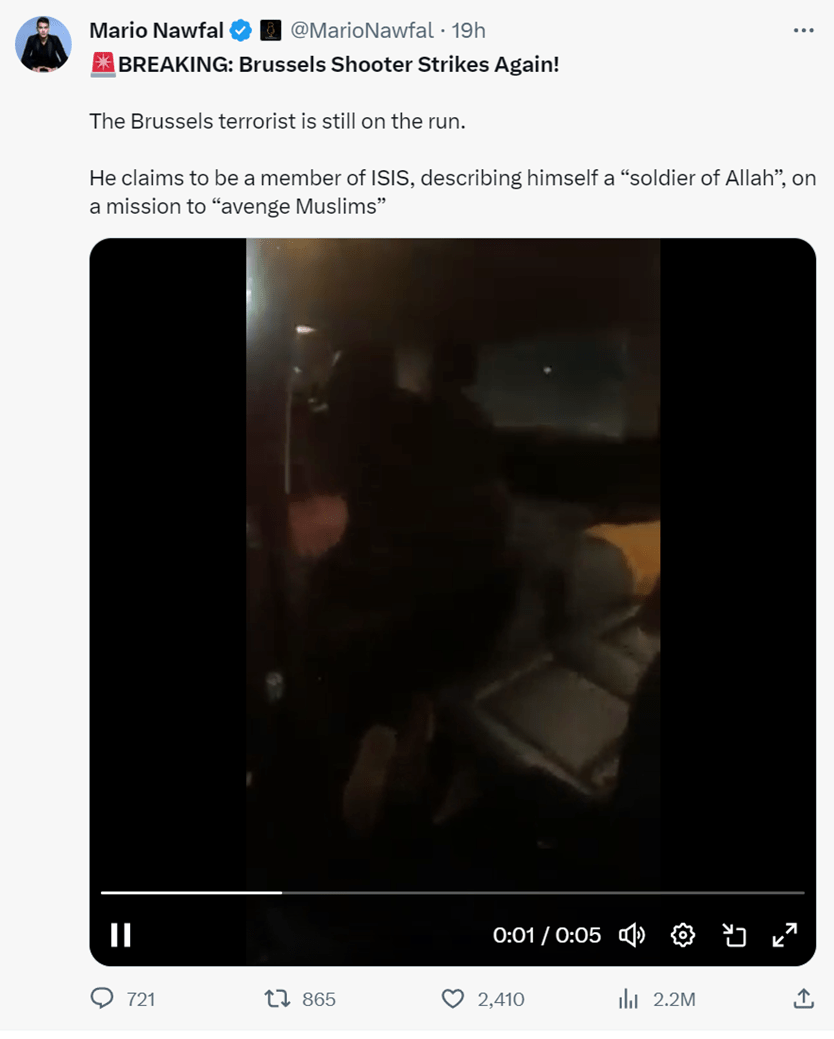
Two examples of tweets with disturbing footage.
Posts from @visegrad24 sometimes used “culture war” frames and divisive imagery:
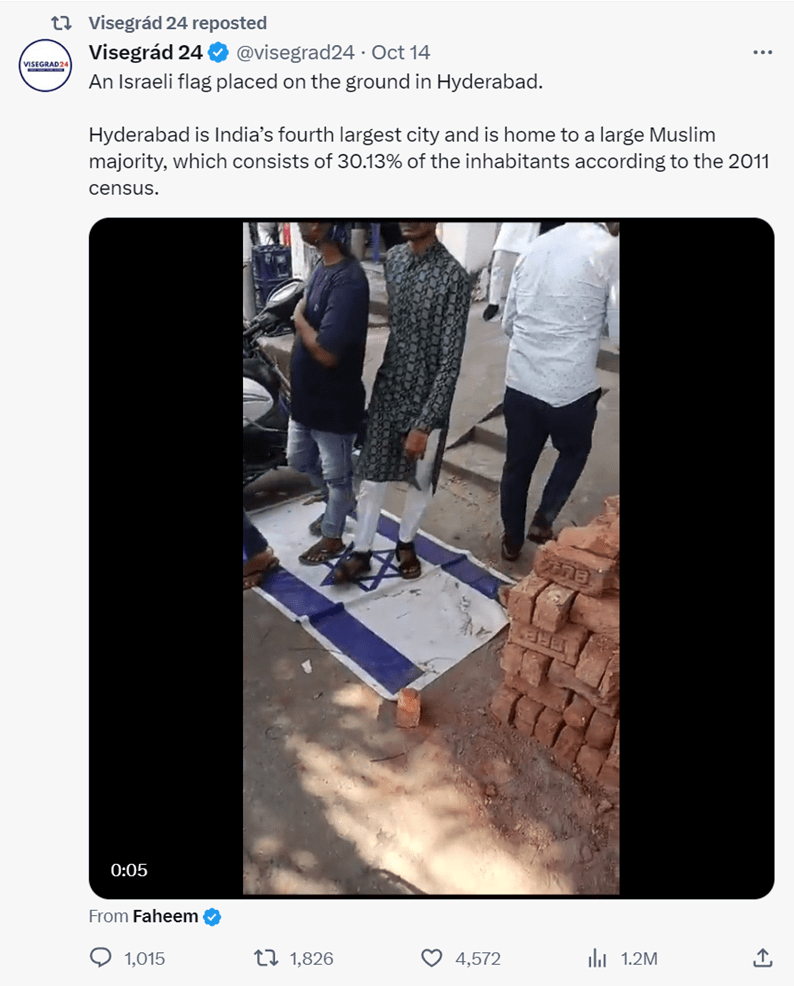
Divisive imagery from the @visegrad24 account.
While traditional news does at times use such imagery as well, the sheer volume of these tweets, combined with the lack of deeper analysis or context mentioned above, created for our analysts the sense of a constant stream of decontextualized anger and violence when analyzing these accounts.
They do not have a unifying ideology, but share a style of posting.
The “new elites” do not have a unifying overarching ideology on the issue of the current conflict. Some accounts embraced a notable pro-Palestine stance, and others a pro-Israel stance. Still others amplified both sides of the conflict, or posted in a neutral tone. All of these accounts (except @spectatorindex) shared footage of airstrikes and the images of their aftermath in neighborhoods in Israel and/or Gaza, however the images and videos of graphic violence they chose to share depended on their stance on the conflict. Overall, the group is more unified in a style of posting than by a particular worldview.
They may have impact on the larger news ecosystem — but our current tools lack the ability to determine this.
While these “new elite” accounts far surpass traditional news in influence on X, they are also capable of amplifying it when it suits their purpose. In one instance, some accounts endorsed and amplified a pervasive rumor that Hamas beheaded babies during their initial attack on Israel. Initially, many gave credit to this rumor, yet no verification has emerged. This rumor was widely circulated online and later picked up by established news outlets such as CNN.
In this case, @Visegrad24 shared the clip from CNN on October 11 without a link to the CNN site or the original tweet by CNN. CNN later posted two corrections on the issue, including one from a reporter who apologized, a personal correction that received over 13 million views. We could find no corrections posted by @Visegrad24 on the rumor.

It is important to highlight that this is one area where lack of access to X data hinders us — our current toolset allows us to see who amplified what rumor but does not allow us to track how that rumor came to the attention of broader media. A better analysis would look at how an initial news report was clipped into a viral video, amplified by a variety of accounts on X, reaching mainstream media and eventually ending up in a statement from the President of the United States — but we do not currently have the capability to look at that due to restrictions in access.
Conclusion
Crisis events produce confusing information landscapes, and the current crisis is no exception. Still, Twitter/X has weathered similar crises before, most notably the invasion of Ukraine. In the case of that invasion, many experts noted that the high-attention nature of that event produced high-quality, journalistic outputs that served as a countering force to much of the misinformation that was circulated at that time. Those outputs included not only circulated fact-checks, but on-the-ground reports from journalists, deeper pieces laying out the history and nature of the conflict, and vetted, contextualized video that could be shared as opposed to the unsourced videos circulating on the platform.
Online we have seen many users of X describe their experience of this crisis as different. Some of that may result from the more ambiguous nature of the larger conflict, especially as the news cycle moves from the unambiguous horror of the initial attack to concerns about Israel’s response. However, our investigation here suggests an additional factor: in Musk’s short tenure as owner of the platform, a new set of news elites has emerged. These elites post frequently, many sharing unvetted content and emotionally charged media. While sharing no single political ideology, many embrace a similar culture of rapid production of unlinked or ambiguously sourced content, embracing a “firehose of media” ethos that places the onus of verification on the end-user. This occurs in an environment that has been shorn of many of the “credibility signals” that served to ground users in the past — checkmarks that indicated notability, fact-checks distributed through Twitter Trends, and Twitter/X-based labeling of deceptive content. Even fundamental affordances of the web — such as simple sourcing through links — have been devalued by the platform, and, perhaps as a result, by the new elites that now direct its users’ attention.
While there are many recommendations we might offer to X, we end instead with a call to researchers and the press. For a long time, the joke about Twitter research was that it was an example of the “drunkard’s key search.” The story goes like this: a man, drunk, is found searching for his key under the brightness of a streetlight. A passerby stops to help, and after a prolonged search suggests that perhaps they will never find it. “Shoot,” says the drunkard, “I wish I had never dropped it in those bushes.”
“The bushes!” replies the passerby, “But if you dropped it in the bushes why are we searching in the street?”
“Because the light is better here,” the man replies.
For many years, that felt like the story of Twitter — the ease of research on the platform and the presence of many journalists on it made it the locus of research, even if it was perhaps not always where the real story was. But as the tools that researchers have used to monitor Twitter and X are retired and research becomes difficult once again; as reporters are less-engaged with the platform and less aware of its larger trends — it may be that we risk an overcorrection. Our research suggests that X is changing rapidly, in ways not fully apparent even to people like us, who have followed the platform for years. In the end, it may be important for researchers to turn at least some of our attention back to the platform — precisely because it now operates, metaphorically at least, in the dark.
Mike Caulfield is a research scientist at the University of Washington’s Center for an Informed Public; Mert Can Bayar is a CIP postdoctoral scholar; Ashlyn B. Aske is a CIP graduate research assistant.
Notes
[1] To check this we ran a second collection at a lower resolution on October 14 — collecting tweets in the period of October 7 to October 10 that had at least 1,000 likes. While the change in resolution changed the specific rankings, we did not find any significant difference in the top accounts surfaced as a whole.

